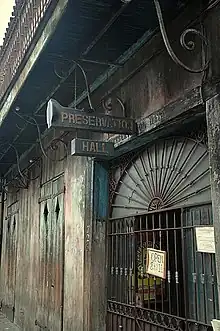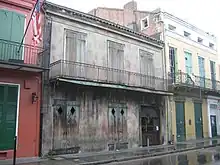
Preservation Hall is a jazz venue in the French Quarter of New Orleans, Louisiana. The building is associated with a house band, a record label, and a non-profit foundation.
History of the jazz hall

In the 1950s, art dealer Larry Borenstein from Milwaukee managed what would become Preservation Hall in the French Quarter as an art gallery, Associated Artists. To attract customers, he invited local jazz musicians to play for tips. After a time, the music started drawing more attention than the art.[1] In May 1961, Borenstein turned management over to Ken Grayson Mills and Barbara Reid, who turned it into a music venue and named it "Preservation Hall".[2][3]
After their honeymoon in 1961, Allan Jaffe and his wife Sandra visited to hear some traditional New Orleans jazz. The Jaffes were from Pennsylvania. Allan Jaffe was a tuba player who had graduated from the Wharton School of Business in Philadelphia, while his wife had been employed at an advertising agency. They attended concerts, grew to love the French Quarter, and stayed longer than they had intended. Borenstein asked if they wanted to manage Preservation Hall, and they agreed, taking over in September 1961.[4]
Allan Jaffe hired local musicians whose ages ranged from the 60s to the 90s. Many were struggling with poverty, racism, and illness. At first, the Jaffes served no alcohol, used no amplification, and refused to advertise. In 1963, Allan Jaffe began to tour with bands in the U.S. and in other countries. These tours included such musicians as pianist Sweet Emma Barrett, trumpeter Kid Thomas Valentine, brothers Percy Humphrey and Willie Humphrey, pianist Billie Pierce and her husband, trumpeter De De Pierce. The most popular was clarinetist George Lewis, whose reputation preceded the Hall. Fans from all over the world came to New Orleans to hear traditional jazz.[4]
The foundation
The Preservation Hall Foundation is a 501(c)(3) organization primarily dedicated to Preservation Hall's educational initiatives, including but not limited to providing private lessons to youth taught by New Orleans jazz musicians, coordinating group lessons with the Preservation Hall Junior Jazz Band, presenting workshops during Preservation Hall Jazz Band tours, or maintenance of the ever-growing Preservation Hall archives.
Further reading
- Preservation Hall by William Carter
- "Song for My Fathers" by Tom Sancton
References
- ↑ Farbenbloom, Frank (30 April 2020). "Remembering Larry Borenstein and Preservation Hall". The Syncopated Times. Retrieved 30 April 2020.
- ↑ Ekins, Richard. "Preservation Hall: The Rest of the Story". Just Jazz, No. 235, pp. 18-25. Retrieved 2020-06-23.
- ↑ Ekins, Richard. "On the Origin of Preservation Hall". Just Jazz, No. 255, pp. 20-29. Retrieved 2020-06-23.
- 1 2 Sancton, Tom (9 December 2011). "The Venerable, Musical History of Preservation Hall in New Orleans". Vanity Fair. Retrieved 18 November 2017.